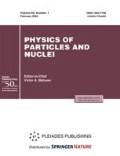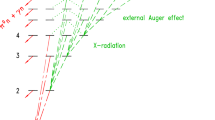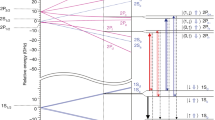Abstract
The prospects of tests of CPT symmetry using precision spectroscopy of antihydrogen are discussed with special emphasis on the ground-state hyperfine structure, a measurement of which is the aim of the ASACUSA collaboration at the AD/ELENA facility of CERN. Ongoing parallel experiments using hyperfine spectroscopy of hydrogen and deuterium aiming at studying Lorentz invariance by determining coefficients of the Standard Model Extension framework are described.


Similar content being viewed by others
Notes
In the following, precision stands for, unless otherwise stated, relative precision.
REFERENCES
E. Widmann, J. Eades, R. S. Hayano, M. Hori, D. Horváth, T. Ishikawa, B. Juhász, J. Sakaguchi, H. A. Torii, H. Yamaguchi, and T. Yamazaki, “Hyperfine Structure Measurements of Antiprotonic Helium and Antihydrogen,” in The Hydrogen Atom: Precision Physics of Simple Atomic Systems, Ed. by S. G. Karshenboim, F. S. Pavone, F. Bassani, M. Inguscio, and T. W. Hänsch (Springer, Berlin–Heidelberg, 2001) pp. 528–542.
Y. Enomoto et al. (ASACUSA Cusp Collab.), “Synthesis of cold antihydrogen in a cusp trap,” Phys. Rev. Lett. 105, 243401 (2010).
N. Kuroda et al. (ASACUSA Cusp Collab.), “A source of antihydrogen for in-flight hyperfine spectroscopy,” Nat. Commun. 5, 3089 (2014).
B. Kolbinger et al. (ASACUSA Cusp Collab.), “Measurement of the principal quantum number distribution in a beam of antihydrogen atoms,” Eur. Phys. J. D 75, 91 (2021).
M. Diermaier, C. B. Jepsen, B. Kolbinger, C. Malbrunot, O. Massiczek, C. Sauerzopf, M. C. Simon, J. Zmeskal, and E. Widmann, “In-beam measurement of the hydrogen hyperfine splitting and prospects for antihydrogen spectroscopy,” Nat. Commun. 8, 15749 (2017).
P. Zyla et al. (Particle Data Group Collab.), “Review of particle physics,” Prog. Theor. Exp. Phys. 2020, 083C01 (2020).
C. G. Parthey, A. Matveev, J. Alnis, B. Bernhardt, A. Beyer, R. Holzwarth, A. Maistrou, R. Pohl, K. Predehl, T. Udem, T. Wilken, N. Kolachevsky, M. Abgrall, D. Rovera, C. Salomon, P. Laurent, and T. W. Hänsch, “Improved measurement of the hydrogen 1S–2S transition frequency,” Phys. Rev. Lett. 107, 203001 (2011).
A. Matveev, C. G. Parthey, K. Predehl, J. Alnis, A. Beyer, R. Holzwarth, T. Udem, T. Wilken, N. Kolachevsky, M. Abgrall, D. Rovera, C. Salomon, P. Laurent, G. Grosche, O. Terra, T. Legero, H. Schnatz, S. Weyers, B. Altschul, and T.W. Hänsch, “Precision measurement of the hydrogen 1S–2S frequency via a 920-km fiber link,” Phys. Rev. Lett. 110, 230801 (2013).
S. Karshenboim, “Precision physics of simple atoms: QED tests, nuclear structure and fundamental constants,” Phys. Rep. 422, 1—63 (2005).
N. Bezginov, T. Valdez, M. Horbatsch, A. Marsman, A. C. Vutha, and E. A. Hessels, “A measurement of the atomic hydrogen Lamb shift and the proton charge radius,” Science 365, 1007–1012 (2019).
M. Ahmadi et al. (ALPHA Collab.), “Characterization of the 1S–2S transition in antihydrogen,” Nature 557, 71–75 (2018).
M. Ahmadi et al. (ALPHA Collab.), “Investigation of the fine structure of antihydrogen,” Nature 578, 375—380 (2020).
M. Ahmadi et al. (ALPHA Collab.), “Observation of the hyperfine spectrum of antihydrogen,” Nature 548, 66–69 (2017).
P. Crivelli, D. Cooke, and M. W. Heiss, “Antiproton charge radius,” Phys. Rev. D 94, 052008 (2016).
S. Ulmer, C. Smorra, A. Mooser, K. Franke, H. Nagahama, G. Schneider, T. Higuchi, S. V. Gorp, K. Blaum, Y. Matsuda, W. Quint, J. Walz, and Y. Yamazaki, “High-precision comparison of the antiproton-to-proton charge-to-mass ratio,” Nature 524, 196–199 (2015).
C. E. Carlson, V. Nazaryan, and K. Griffioen, “Proton structure corrections to electronic and muonic hydrogen hyperfine splitting,” Phys. Rev. A 78, 022517 (2008).
C. Smorra, S. Sellner, M. J. Borchert, J. A. Harrington, T. Higuchi, H. Nagahama, T. Tanaka, A. Mooser, G. Schneider, M. Bohman, K. Blaum, Y. Matsuda, C. Ospelkaus, W. Quint, J. Walz, Y. Yamazaki, and S. Ulmer, “A parts-per-billion measurement of the antiproton magnetic moment,” Nature 550, 371–374 (2017).
V. A. Kostelecký and R. Potting, “CPT, strings, and meson factories,” Phys. Rev. D 51, 3923–3935 (1995).
D. Colladay and V. A. Kostelecký, “CPT violation and the Standard Model,” Phys. Rev. D 55, 6760–6774 (1997).
D. Colladay and V. Kostelecký, “Lorentz-violating extension of the Standard Model,” Phys. Rev. D 58, 116002 (1998).
V. A. Kostelecký and N. Russell, “Data tables for Lorentz and CPT violation,” Rev. Mod. Phys. 83, 11–32 (2011).
V. A. Kostelecký and N. Russell, “Data tables for Lorentz and CPT violation,” arXiv:0801.0287v14.
M. Hori, H. Aghai-Khozani, A. Sótér, D. Barna, A. Dax, R. Hayano, T. Kobayashi, Y. Murakami, K. Todoroki, H. Yamada, D. Horváth, and L. Venturelli, “Buffer-gas cooling of antiprotonic helium to 1.5 to 1.7 K, and antiproton-to-electron mass ratio,” Science 354, 610–614 (2016).
J. Adam et al. (ALICE Collab.), “Precision measurement of the mass difference between light nuclei and anti-nuclei,” Nat. Phys. 11, 811–814 (2015).
D. F. Phillips, M. A. Humphrey, E. M. Mattison, R. E. Stoner, R. F. C. Vessot, and R. L. Walsworth, “Limit on Lorentz and CPT violation of the proton using a hydrogen maser,” Phys. Rev. D 63, 111101 (2001).
M. A. Humphrey, D. F. Phillips, E. M. Mattison, R. F. C. Vessot, R. E. Stoner, and R. L. Walsworth, “Testing CPT and Lorentz symmetry with hydrogen masers,” Phys. Rev. A 68, 063807 (2003).
C. Malbrunot et al. (ASACUSA Cusp Collab.), “A hydrogen beam to characterize the ASACUSA antihydrogen hyperfine spectrometer,” Nucl. Instrum. Methods Phys. Res., Sect A 935, 110–120 (2019).
R. Bluhm, V. Kostelecký, and N. Russell, “CPT and Lorentz tests in hydrogen and antihydrogen,” Phys. Rev. Lett. 82, 2254–2257 (1999).
C. Malbrunot et al. (ASACUSA Cusp Collab.), “The ASACUSA antihydrogen and hydrogen program: Results and prospects,” Phil. Trans. R. Soc. A 376, 20170273 (2017).
E. Widmann et al. (ASACUSA Cusp Collab.), “Hyperfine spectroscopy of hydrogen and antihydrogen in ASACUSA,” Hyperfine Interact. 240, 5 (2019).
V. A. Kostelecký and M. Mewes, “Fermions with Lorentz-violating operators of arbitrary dimension,” Phys. Rev. D 88, 096006 (2013).
V. A. Kostelecký and A. J. Vargas, “Lorentz and CPT tests with hydrogen, antihydrogen, and related systems,” Phys. Rev. D 92, 056002 (2015).
ACKNOWLEDGMENTS
The authors thanks his colleagues of the ASACUSA collaboration for the continuous cooperation and many fruitful discussions, in particular T. Yamazaki, as well as extensive discussions with S. Karshenboim, V.A. Kostelecky, and R. Lehnert.
Funding
The work was supported by the Austrian Science Fund (FWF): W1252-N27, the Grant-in-Aid for Specially Promoted Research 24000008 of Japanese MEXT, Special Research Projects for Basic Science of RIKEN, and Università di Brescia and Istituto Nazionale di Fisica Nucleare.
Author information
Authors and Affiliations
Consortia
Corresponding author
Ethics declarations
The author declares that he has no conflicts of interest.
Rights and permissions
About this article
Cite this article
Widmann, E., for the ASACUSA Cusp Collaboration. Hyperfine Spectroscopy of Antihydrogen, Hydrogen, and Deuterium. Phys. Part. Nuclei 53, 790–794 (2022). https://doi.org/10.1134/S1063779622040141
Received:
Revised:
Accepted:
Published:
Issue Date:
DOI: https://doi.org/10.1134/S1063779622040141




